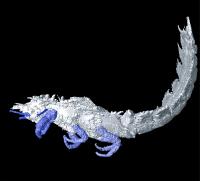
This shows the spiney-type insect. Writing in the journal PLoS One, the scientists have used a high resolution form of CT scanning to reconstruct two 305-million year old juvenile insects. Without the pioneering approach to imaging, these tiny insects – which are three-dimensional holes in a rock – would have been impossible to study.
By placing the fossils in a CT scanner, and taking over 3,000 X-rays from different angles, the scientists were able to create 2,000 slices showing the fossil in cross section.
From these slices the researchers created 3D digital reconstructions of the fossils. This process allows them to learn more about the lifestyle, biology and diet of the insects, one of which is similar to a modern day cockroach, and glimpse fascinating insights about how both were adapted for survival.
One of the insects reconstructed by the scientists is characterised by a large number of sharp spines. It is a new species and genus which does not exist today.
The other is an early predecessor of one of the great survivors of the insect world, the cockroach, and is one of the best preserved examples of this age ever seen by insect palaeontologists. Researchers suspect from its well preserved mouthparts that it survived by eating rotting litter from the forest floor.
Both are members of a group called the Polyneoptera – which includes roaches, mantises, crickets, grasshoppers and earwigs. But analysing the exact relationships of the insects will be difficult for the researchers, led by Dr Russell Garwood of the University of Manchester's School of Materials, as insects have a habit of dramatically changing appearance as they develop.
Dr Garwood said: "The most dramatic change is seen in insects like butterflies, which change from a larva, to chrysalis, to adult. But relatively few people look to the fossils try and work out how such a life cycle may have evolved.
"We are hoping that work like this will allow us to better understand the biology and development of these early insects, and how major innovations may have come about.
"Around this time a number of early 'amphibians' were insectivores – they lived by eating a lot of insects. The spiney creature was a sitting duck, as it couldn't fly, so the spines probably made it less palatable. It is bizarre – as far as we're aware, quite unlike any members of the Polyneoptera alive today."
"The roach nymph is much like modern day cockroaches – although it isn't a 'true' cockroach, as it may well predate the split between true cockroaches and their sister group, the mantises."
"This is very much a first step, and I'll be spending the next few years looking at other fossil insects to build on this work.
Professor Philip Withers, co-author on the paper, added: "I am very excited by our fossil work which is providing unique information in 3D." Source : University of Manchester
 Print Article
Print Article Mail to a Friend
Mail to a Friend
